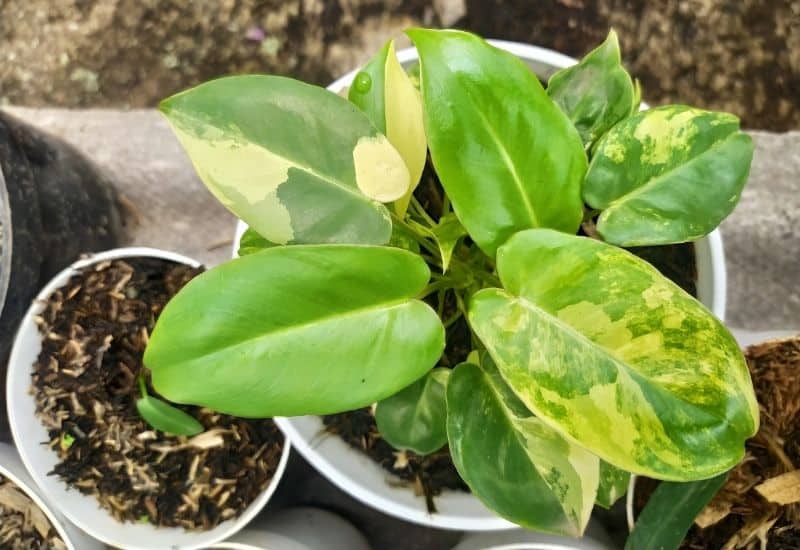We love an indoor plant that is so easy to grow that even those of us without a green thumb can be successful. The Philodendron Burle Marx is a gem of a houseplant that gives off an exotic, tropical vibe with minimal effort, making it a perfect plant choice for just about any home.
Philodendron Burle Marx Care Guide Overview
- How To Plant (when & where)
- How To Grow (staking, watering, fertilizing, humidity, mulching)
- How To Trim And Prune
- How To Pot And Repot
- How To Propagate (when & how)
- And Pests and Diseases, Plant Species, Companions, Toxicity
Characteristics of the Philodendron Burle Marx
- Origin: a tropical native of Brazil
- Indoor or Outdoor plant: Indoor
- Height and Structure: up to 24 “(60cm) tall, leaves up to 10” (25 cm)
- Temperature: between 64-79 F (18-26 C)
- Flower Color: none
How to Plant the Philodendron Burle Marx

Planting Time
To plant a young Burle Marx or to replant a mature specimen, the best planting time is prior to the growing season. Plant this Philodendron species before new growth begins for the plant in later winter or early spring.
Spacing
The Burle Marx is a relatively slow grower, but each cutting or repotted plant should be planted alone in a pot to allow for comfortable growth of this indoor Philodendron.
Light
While the Burle Marx is a tropical plant, it does not do well with direct sunlight. Instead, indirect medium lighting is perfect for this variety. If the Burle Marx is not putting out leaves, dropping leaves, or growth has stopped, then an increase in indirect lighting will usually return the plant to full health. Conversely, when a Burle Marx experiences direct sunlight, the leaves may scorch and turn black or yellow.
Placing the plant in a window that is north-facing will usually provide an adequate amount of safe sunlight.
Soil
This tropical beauty needs well-drained soil to be happy. Potting mixes that provide aeration and are light are perfect for the Burle Marx, allowing the plant to experience needed oxygenation for its growth. Soil that does not drain well can lead to root rot, potentially fatal for the tropical houseplant.
Additionally, Burle Marx likes more acidic soil, so PH levels should be between 5.6 to 6.5 for maximum contentment of this exotic houseplant.
How to Grow the Philodendron Burle Marx

Growth habits
Known as a slow grower, the Burle Marx plant does not show rapid growth even when healthy. A typical plant will only need to be repotted once every 2 years or so once the roots have begun to show through the drainage holes of the pot. A slow-down or lack of growth can be due to overwatering, too much sunlight, or the need to be repotted into a larger vessel.
Additionally, the dark, elongated leaves should be a glossy green when the plant is healthy and growing strong.
Staking
The Burle Marx is notable for its stunning red stalks that hold up the long, dark green leaves. With the upward growth of the stalks comes the need for staking. Once the stalks have started their upward path and leaves have sprouted, bamboo or other light natural stakes should be secured next to the tender stalks to encourage strong stalk growth and maturity.
This beautiful plant can also live in a hanging basket with its stalks and leaves gracefully leaning out and down from the suspended pot. In this case, no staking is needed since gravity will keep the stalks and leaves suspended beautifully downward, although owners may wish to turn the plant toward the light source for best results.
Watering
The Burle Marx does not too be damp, so watering should only occur when the top two inches of the soil are dry to the touch. The soil should drain the water well, and no standing water should be visible on the plant for its best health. During its dormant seasons, fall and winter, the Burle Marx plant only needs watering about one time per week. But during its growth time or shortly after being planted or repotted, this houseplant needs more frequent drinks.
During these higher growth periods when the temperatures are warmer and sunshine is more plentiful, this thirsty plant will love a drink of water 3-4 times per week or even more often if the soil is dry down to two inches.
Fertilizing
During Burle Marx’s dormant or slow-growing seasons of fall and winter, no fertilizer is needed for the plant to stay healthy. In fact, fertilizing during this time might actually harm the plant by introducing too many nutrients during a time when this Philodendron should be dormant and not growing.
However, in the spring and summer growth periods, this plant will thrive with minimal fertilizer additions as well. Add in a foliage fertilizer in a liquid form that is not high in phosphorous for best growth results for the Burle Marx variety.
Humidity
As a tropical plant, this Philodendron loves higher humidity. While not a requirement for a healthy plant, ensuring at least regular humidity over a dry environment is optimal for this houseplant to thrive. To increase humidity during drier times, like during the winter seasons when indoor heat can reduce the natural humidity of the home, add in moisture to the air.
One simple way to increase humidity for this tropical plant is to place a saucer of pebbles sitting in the water underneath the plant’s pot. This allows the tropical plant to absorb extra water as it is needed but be sure to not overfill the pebble tray’s water level. Doing this may actually lead to root rot of the Burle Marx if it is left to sit in undrained water.
Another option would be to regularly mist the plant with a spray bottle, lightly covering the leaves with a fine spray to amp up the moisture the plant experiences. A humidifier can also add in needed moisture, especially during dry seasons. This tropical plant must have plenty of humidity to grow and thrive, and a complete lack of humidity for an extended time period could kill the Burle Marx.
Temperature
As an indoor houseplant, the Burle Marx needs a warmer air temperature to thrive and be content. Indoor temperatures usually are well within the range of 60 and 75 F, perfect for this Philodendron. But if temperatures drop, like when a plant is left next to a drafty window or when it is exposed to frost, the Burle Marx will stop growing or wilt.
Trimming and Pruning
As a tropical plant, this variety of Philodendron doesn’t need much if any trimming or pruning to look and feel its best. Any leaves that have browned, yellowed, or wilted can be snipped off for plant health. For plants that begin to appear leggy, pruning can be done to increase the bushiness of this Philodendron. Pruning is best done prior to the growing seasons of spring and summer to ensure the healthiest of Burle Marx.
Pot and Repotting
The Burle Marx plant will need to be planted in a pot no bigger than a few inches around than the initial stem. Then, repotting should take place to a larger pot once the roots are visible in the drainage hole areas of the plant’s home. Since the plant is relatively slow growing to its full height of 24 or so inches, this repotting may need to occur only once every year or two at the most.
Make sure to repot during the dormant season occurring during the fall and winter to avoid damaging or slowing growth of the Burle Marx during the warmer, sunnier months.
Propagation
In addition to seeds, the Burle Marx plant can be propagated using two methods: with stem cuttings and by air layering.
- Stem Cuttings This method begins with shearing a 2- to 4-inch stem portion just below the leaf node off of the mother plant. Then, cure the cutting for 7 to 10 days in a warm location, allowing the stem end to callous over. When the stem is cured, plant in a prepared soil an inch or two deep and secure with a stake so the tender plant can begin to strengthen and grow vertically. Fertilize and water lightly, placing the pot in a sunny north-facing windowsill while it begins the month-long rooting process to become a fledgling Philodendron.
- Air Layering This method involves creating a small wound on the mother plant’s main stem that is held open with a toothpick, packed with moss, and then held in place with clear tape. The barrier keeping the wound from closing encourages the plant to create a new root system right at the wound. Once the roots reach 3 inches in length, the stem is removed at the wound to be planted in a pot readied with prepared soil. The new plant is now ready to be treated as a Burle Marx plant in its growing season and will begin to grow and strengthen as an individual plant.
Pests and Common Problems
Generally, Philodendrons are not plagued by many pests or diseases. A few bugs and common problems to watch out for are:
- Mealybugs are waxy bugs that look like they are enveloped in cotton, and this white substance that they leave behind on the Burle Marx is a tell-tale sign that there is an infestation. To avoid mealybugs from settling in and stealing the life-giving sap from your plant, spray the plant with neem oil and carefully wipe down infested leaves every few days until there is no sign of the bugs or their leavings.
- Thrips are tiny thread-like bugs that suck the sap from the Burle Marx plant. Neem oil is also effective at ridding the Philodendron of a thrip infestation.
- Leaf browning can be caused by over-watering or a buildup of salt. If watering is ruled out, then try flushing the soil’s salt content out using a low, constant flow of water over the pot, allowing the excess salt to be flushed out through the drainage holes.
- Water spots may occur on the Burle Marx leaves, indicating too hard of water is being used. To remedy when soft water is not available, allow hard water to sit in a bucket overnight to allow some of the harsh minerals to evaporate prior to watering the plant. Softer water is better for a healthy plant.
Plant Species
Noteworthy Species
The Philodendron Gloriosum is a beautiful cousin of the Burle Marx, noted by its larger, white-veined leaves that grow in a stunning heart shape. This variety grows by creeping horizontally rather than in an upright fashion like its cousin Burle Marx.
Another hybrid is the Philodendron Burle Marx Fantasy that is characterized by the gray-green color of the elongated leaves. The Fantasy hybrid shares just about all of the other characteristics of the Burle Marx other than the leaf coloring that is also reversed with a gorgeous silvery hue.
Companions
What are good neighbors?
The easy to grow Burle Marx’s unique tropical feel is complemented by other exotic plants that need bright light as well as a higher humidity home. Some of the best companions for this plant are the Bird of Paradise (Strelitzia), the Gardenia (Gardenia), the Canna (Canna), the Bush Lily (Clivia) and the Passion Vine (Passiflora).
Toxicity
Is the plant toxic?
Unfortunately, this gorgeous exotic beauty is toxic to humans if ingested. The oxalate crystals in the Burle Marx, if ingested, can cause pain and irritation of the mouth and throat, vomiting or difficulty in swallowing.
Is it toxic for cats or dogs?
Animals should also not ingest any portion of the Philodendron Burle Marx, as it is just as toxic to animals.


